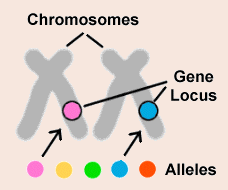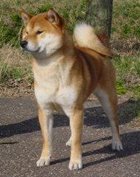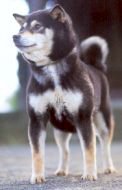|
The coat colouring genes in the Shiba
|
|
The following text on the Shiba's coat colours is an excerpt from a longer article entitled "Genetics Primer", written originally in Czech by Hana PetrusovŠ. Mrs. PetrusovŠ had studied genetics at the Physiological Institute of the Czechoslovak Academy of Sciences (»SAV) in Prague. She has been breeding dogs for decades and in 1990 she introduced the first Shibas to the Czech Republic and has been breeding them ever since.
The introduction was added by the translator.
|
Introduction
A gene is a unit of heredity. Dogs have thousands of genes, approximately 200,000. Each gene is located on a specific chromosome and there again at a specific location or genetic locus.
 In the nucleus of each somatic cell dogs have 78 of these chromosomes, or 39 pairs of chromosomes (human beings only have 23). These chromosomes include the predominant part of the dog's hereditary information. All somatic cells contain each chromosome and consequently each gene in duplicate (diploid), one from the sire and the other from the dam. Every puppy thus is genetically moulded half by its father and half by its mother.
In the nucleus of each somatic cell dogs have 78 of these chromosomes, or 39 pairs of chromosomes (human beings only have 23). These chromosomes include the predominant part of the dog's hereditary information. All somatic cells contain each chromosome and consequently each gene in duplicate (diploid), one from the sire and the other from the dam. Every puppy thus is genetically moulded half by its father and half by its mother.
In the sex cells (gametes) the chromosomes exist not in pairs but singly (haploid). During the union of the female and the male sex cell the dog gets a set of chromosomes each from father and mother resulting in a double set of chromosomes, whereby chromosome 39 determines the gender. This means that a bitch has 38 pairs of chromosomes and two identical sex chromosomes (XX), a male dog 38 pairs of chromosomes and two dissimilar sex chromosomes (XY) which however are not differentiated.
Because two chromosomes are always identical, every dog has always two genes of the same kind. These theoretically identical genes may occur however in a different form, in which case they are called alleles. Often there is a series of alleles for one locus.
A dog can have just two alleles of each gene, one on the chromosome inherited from the father, the other on the chromosome inherited from the mother. These alleles can be identical or they can differ. But their number is always just two, because merely the two loci of the two chromosomes are existent.
Dogs have twelve distinct loci with different alleles which are responsible for the coat colour. The following list specifies the name of the locus (and the origin of name) accompanied by a short description (according to Clarence C. Little, The Inheritance of Coat Color In Dogs, New York 1957).
A (Agouti)
The A series with 6 alleles (As, ay, aw, as, at, a) controls the number and spreading of the dark (black, brown) coat pigments.
B (Black)
The B series with 2 alleles (B, b) enables or disables the generation of dark pigments on the body.
C (Concentration)
The C series with 4 alleles (C, cch, ce, ca) controls the intensity of a colour. The C locus has the strongest effect on the pheomelanin pigment for red or yellow hair.
D (Dilution)
The D series with 2 alleles (D, d) controls the dilution of the dark pigments (just as C controls the light pigments).
E (Extension)
The E series with 4 alleles (E, e, ebr, Em) enables the spreading of dark pigment all over the coat.
G (Greying)
The G series with 2 alleles (G, g) enables or disables the dilution of puppies born dark-coated.
M (Merle)
The M series with 2 alleles (M, m) causes a marbled (M) or a normal (m) coat.
P (Pink-Eye Dilution)
The P series with 2 alleles (P, p) disables or enables the dilution of whatever colour is found.
P = non-pink, therefore no dilution; p dilutes black, and yellow in coat and dilutes eyes to pink.
R (Roan)
The R series with 2 alleles (R, r) enables or disables a pattern of intermingled white and coloured hairs on some part of the body.
S (Spotting)
The S series with 4 alleles (S, si, sp, sw) controls white spotting.
T (Ticking)
The T series with 2 alleles (T, t) enables or disables mottling, i.e. a pattern of many small pigmented spots on a white or roan background.
W (White)
The W series with 2 alleles (W, w) enables or disables a white dilution.
The coat colours
The Shiba standard allows three coat colours: red/yellow (*), sesame and black with yellow markings (black and tan). All colours must have urajiro, i.e. a brighter coat around the muzzle, on the throat, the lower part of the body, the tail and on the legs. Some Shibas have in addition to urajiro also various-sized white markings, often on the paws and the chest. There are no completely black Shibas, nor are there wolf grey, brindle, blue or chocolate ones.
Now let's see which genes control the Shiba's coat colouring.
[* Translator's note: In the Czech Republic different names are used for two of the three standard colours recognised internationally. Therefore some remarks on naming are necessary.
The colour "sesame" is also in Czech referred to as sesame. Instead of "black and tan" mostly "black with yellow markings" or "black-yellow" is used. The real topic for discussion however is supplied by the third coat colour.
In international practice "red" is always stated as an admissible colour for the Shiba. This is questionable from a genetic point of view, because the Shiba's red is derived from alleles at the C locus which mainly control the intensity of the yellow colour (see below). In this context you must consider that the English translation of the Shiba standard from 1987 which is currently valid is based on the later Japanese Nihon Ken Hozonkai standard and not on the original Nippo standard from 1935 that specifies 9 different hues for the Shiba
(tawn, white, wheaten etc.), but does not include red. Apparently the "red" in the international standard is just a collective term for the different hues in the original Japanese standard. Hence in the Czech Republic mostly the word "zlatŠ" (= golden), or sometimes "ĺlutŠ" (= yellow), is used to describe the Shiba's coat colour internationally recognised as "red".
By the way, this confusion in colour naming is not Shiba-specific: for example in the English standard for the Doberman Pinscher the coat colour brown is called red, whereas in the German version of the standard it is called brown ("braun").]
1. Yellow in all nuances
Shibas are bred with a great spectrum of yellow colourings. The brightest colouring is almost white, cream, only with some dark shading at the ears. The bitch Orion's Minimeadow Sugar, an import from the USA which can be found in the pedigrees of many Czech Shibas, had such a colouring.
 Quite dark, really "red" Shibas are pretty rare, they have a lusciously mahagony coat. If they have a distinctive urajiro, they are very favoured and in Japan exceedingly in demand. The male dog Shingen Go Chousei Sou (see picture), an import from Japan, has such a colouring. He was presented by his Dutch owner at the Special Show of the Shiba Klub 2003 in Zbraslav. The majority of Shibas is between these extremes, they have a medium yellow that is golden dyed.
Quite dark, really "red" Shibas are pretty rare, they have a lusciously mahagony coat. If they have a distinctive urajiro, they are very favoured and in Japan exceedingly in demand. The male dog Shingen Go Chousei Sou (see picture), an import from Japan, has such a colouring. He was presented by his Dutch owner at the Special Show of the Shiba Klub 2003 in Zbraslav. The majority of Shibas is between these extremes, they have a medium yellow that is golden dyed.
The intensity of yellow is generated by innate genes at the C locus but also by various recessive polygenes (a group of minor, weaker genes scattered over a number of different loci which do not function by themselves but always only in groups), mainly by the rufus polygenes which dilute yellow.
It is well known from practice that the intensity of yellow varies strongly and that it is very difficult to acquire the desired hue. But it has also been proved that two bright-coloured dogs together do not have lusciously yellow offspring, supporting the theory of the recessive origin of the polygen responsible for yellow dilution.
The sesame of yellow coloured dogs is influenced by the umbrous polygenes. They cause a blending of the yellow coat with black hair or just black colouring of the yellow hair tips. But with this colouring it is hard to estimate how intensive the dog's sesame colouring will be. The stronger the blending of the parents' black coat with yellow is, the more probable it will be that the offspring will have dark sesame. But unfortunately many a time it turns out to be a so-called dirty gold with merely some black hairs in the yellow coat, mainly at the tail and the withers.
Completely unexplored are the modifiers generating urajiro. Breeding practice has proved that it is probably a matter of recessive polygenes controlling the generation, extent and degree of brightness on certain parts of the body. So far scientists have not dealt with this problem. Certainly it is hard to achieve a Shiba with a big and very bright urajiro as it is hard to achieve sesame colouring on a large part of the body. Golden and sesame Shibas have, as well as others, the following genes for their coat colouring: ay B C cch (either a single gene or a group of polygenes).
2. Black with yellow markings (black and tan)
 A so-called double colouring, on the Shiba exclusively black (never blue or chocolate) with yellow markings above the eyes, around the muzzle, on the throat, on the belly and on the underside of the legs, is a colouring which in the colour hierarchy is ranked far down because it is caused by the gene at, the last of all alleles of the A series. A two coloured dog can be the offspring of yellow parents, provided that they have the disposition at themselves, but among each other black-yellow partners can only have black-yellow offspring.
A so-called double colouring, on the Shiba exclusively black (never blue or chocolate) with yellow markings above the eyes, around the muzzle, on the throat, on the belly and on the underside of the legs, is a colouring which in the colour hierarchy is ranked far down because it is caused by the gene at, the last of all alleles of the A series. A two coloured dog can be the offspring of yellow parents, provided that they have the disposition at themselves, but among each other black-yellow partners can only have black-yellow offspring.
Also a black-yellow Shiba must have a distinctive urajiro that is normally not as bright as with yellow dogs. On dark Shibas a big bright shirt front connecting the bright area around the muzzle with the bright spot on the chest (see picture) is desired. The extent of the urajiro is with black-yellow Shibas also very accidental and the desired effect is very hard to achieve. The Japanese are well aware of this fact and so black-yellow Shibas with a large urajiro prevail at home at prestigious shows often over the well-known golden champions. Two coloured Shibas thus have the genes at B C cch.
The genetic pattern for the coat colouring in the Shiba is as follows:
| ay |
B |
C |
D |
E |
g |
m |
P |
r |
S |
t |
w |
| at |
|
cch (or a group of polygenes) |
si |
|
|
| |
|
|
|
|
|
|
|
|
sp |
|
|
|
Translated from the Czech by Holger Funk.
Professor Sheila M. Schmutz from the Department of Animal and Poultry Science at the University of Saskatschewan, Canada, has a very informative web site which summarises some of the current DNA research being done on dog coat colour in comparison to the studies of C.C. Little. Please click on the following title: Genetics of Coat Color and Type in Dogs

 In the nucleus of each somatic cell dogs have 78 of these chromosomes, or 39 pairs of chromosomes (human beings only have 23). These chromosomes include the predominant part of the dog's hereditary information. All somatic cells contain each chromosome and consequently each gene in duplicate (diploid), one from the sire and the other from the dam. Every puppy thus is genetically moulded half by its father and half by its mother.
In the nucleus of each somatic cell dogs have 78 of these chromosomes, or 39 pairs of chromosomes (human beings only have 23). These chromosomes include the predominant part of the dog's hereditary information. All somatic cells contain each chromosome and consequently each gene in duplicate (diploid), one from the sire and the other from the dam. Every puppy thus is genetically moulded half by its father and half by its mother.
 Quite dark, really "red" Shibas are pretty rare, they have a lusciously mahagony coat. If they have a distinctive urajiro, they are very favoured and in Japan exceedingly in demand. The male dog Shingen Go Chousei Sou (see picture), an import from Japan, has such a colouring. He was presented by his Dutch owner at the Special Show of the Shiba Klub 2003 in Zbraslav. The majority of Shibas is between these extremes, they have a medium yellow that is golden dyed.
Quite dark, really "red" Shibas are pretty rare, they have a lusciously mahagony coat. If they have a distinctive urajiro, they are very favoured and in Japan exceedingly in demand. The male dog Shingen Go Chousei Sou (see picture), an import from Japan, has such a colouring. He was presented by his Dutch owner at the Special Show of the Shiba Klub 2003 in Zbraslav. The majority of Shibas is between these extremes, they have a medium yellow that is golden dyed.
 A so-called double colouring, on the Shiba exclusively black (never blue or chocolate) with yellow markings above the eyes, around the muzzle, on the throat, on the belly and on the underside of the legs, is a colouring which in the colour hierarchy is ranked far down because it is caused by the gene at, the last of all alleles of the A series. A two coloured dog can be the offspring of yellow parents, provided that they have the disposition at themselves, but among each other black-yellow partners can only have black-yellow offspring.
A so-called double colouring, on the Shiba exclusively black (never blue or chocolate) with yellow markings above the eyes, around the muzzle, on the throat, on the belly and on the underside of the legs, is a colouring which in the colour hierarchy is ranked far down because it is caused by the gene at, the last of all alleles of the A series. A two coloured dog can be the offspring of yellow parents, provided that they have the disposition at themselves, but among each other black-yellow partners can only have black-yellow offspring.